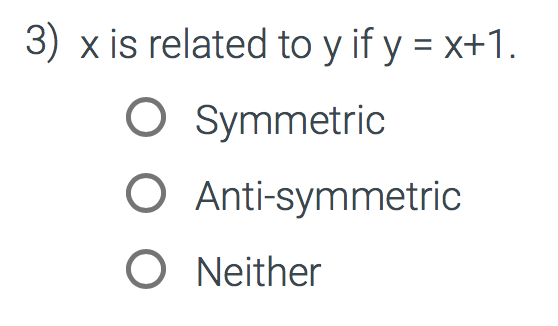Question
I understand how to figure out if a relation is symmetric. This one is not. I don't understand how to figure out if it's anti-symmetric.


I understand how to figure out if a relation is symmetric. This one is not. I don't understand how to figure out if it's anti-symmetric. The textbook says: "One way to show that a relation is anti-symmetric is to take an arbitrary pair of elements in the domain, x and y, and show that the assumptions xRy and yRx necessarily imply that x = y". I don't know what they mean by x=y. Does that apply in this example? How?
Say I let x=3, since it's in the domain of positive real numbers. Then y=3+1=4. Now how do I evaluate x=y+1? And where should I determine if x=y? Explain every step in the simplest way possible. I'm confused.
The domain for each relation described below is the set of all positive real numbers. Select the correct description of the relations. 3) x is related to y if y = x+1. O Symmetric O Anti-symmetric O NeitherStep by Step Solution
There are 3 Steps involved in it
Step: 1

Get Instant Access to Expert-Tailored Solutions
See step-by-step solutions with expert insights and AI powered tools for academic success
Step: 2

Step: 3

Ace Your Homework with AI
Get the answers you need in no time with our AI-driven, step-by-step assistance
Get Started


